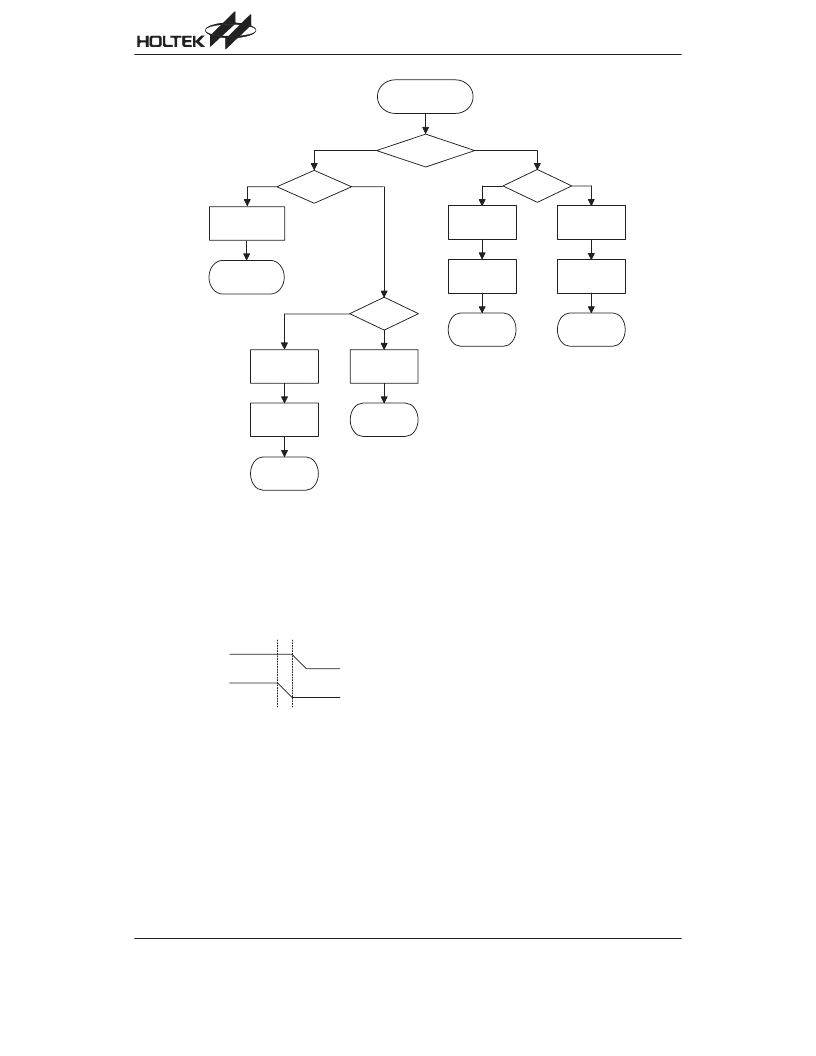- 您現(xiàn)在的位置:買(mǎi)賣(mài)IC網(wǎng) > PDF目錄385399 > HT46C23 (Holtek Semiconductor Inc.) A/D Type 8-Bit MCU PDF資料下載
參數(shù)資料
| 型號(hào): | HT46C23 |
| 廠商: | Holtek Semiconductor Inc. |
| 英文描述: | A/D Type 8-Bit MCU |
| 中文描述: | 的A / D型8位微控制器 |
| 文件頁(yè)數(shù): | 23/48頁(yè) |
| 文件大?。?/td> | 348K |
| 代理商: | HT46C23 |
第1頁(yè)第2頁(yè)第3頁(yè)第4頁(yè)第5頁(yè)第6頁(yè)第7頁(yè)第8頁(yè)第9頁(yè)第10頁(yè)第11頁(yè)第12頁(yè)第13頁(yè)第14頁(yè)第15頁(yè)第16頁(yè)第17頁(yè)第18頁(yè)第19頁(yè)第20頁(yè)第21頁(yè)第22頁(yè)當(dāng)前第23頁(yè)第24頁(yè)第25頁(yè)第26頁(yè)第27頁(yè)第28頁(yè)第29頁(yè)第30頁(yè)第31頁(yè)第32頁(yè)第33頁(yè)第34頁(yè)第35頁(yè)第36頁(yè)第37頁(yè)第38頁(yè)第39頁(yè)第40頁(yè)第41頁(yè)第42頁(yè)第43頁(yè)第44頁(yè)第45頁(yè)第46頁(yè)第47頁(yè)第48頁(yè)

HT46R23/HT46C23
Rev. 1.60
23
May 3, 2004
>
I
K
>
I
K
I
K
7 " (
7 " (
& I
K
7 " (
"
) ,
>
7 " (
'
"
)
,
>
$ "
>
>
$ "
>
'
"
)
1
>
*
>
*
&
*
>
*
&
Start Signal
The START signal is generated only by the master de-
vice. The other device in the bus must detect the START
signal to set the I
2
C Bus busy bit (HBB). The STARTsig-
nal is SDA line from high to low, when SCL is high.
Slave Address
The master must select a device for transferring the
data by sending the slave device address after the
START signal. All device in the I
2
C Bus will receive the
I
2
C Bus slave address (7 bits) to compare with its own
slave address (7 bits). If the slave address is matched,
the slave device will generate an interrupt and save the
following bit (8th bit) to SRW bit and sends an acknowl-
edge bit (low level) to the 9th bit. The slave device also
sets the status flag (HAAS), when the slave address is
matched.
In interrupt subroutine, check HAAS bit to know whether
the I
2
C Bus interrupt comes from a slave address that is
matched or a data byte transfer is completed. When the
slave address is matched, the device must be in trans-
mit mode or receive mode and write data to HDR or
dummy read from HDR to release the SCL line.
SRW Bit
The SRW bit means that the master device wants to
read from or write to the I
2
C Bus. The slave device
check this bit to understand itself if it is a transmitter or a
receiver. The SRW bit is set to 1 means that the mas-
ter wants to read data from the I
2
C Bus, so the slave de-
vice must write data to a bus as a transmitter. The SRW
is cleared to 0 means that the master wants to write
data to the I
2
C Bus, so the slave device must read data
from the I
2
C Bus as a receiver.
*
Start Bit
相關(guān)PDF資料 |
PDF描述 |
|---|---|
| HT46C24 | A/D Type 8-Bit MCU |
| HT46R24 | A/D Type 8-Bit MCU |
| HT46C46 | Cost-Effective A/D Type 8-Bit MCU |
| HT46C47 | Cost-Effective A/D Type 8-Bit MCU |
| HT46R46 | Cost-Effective A/D Type 8-Bit MCU |
相關(guān)代理商/技術(shù)參數(shù) |
參數(shù)描述 |
|---|---|
| HT46C232 | 制造商:HOLTEK 制造商全稱:Holtek Semiconductor Inc 功能描述:A/D Type 8-Bit MCU |
| HT46C24 | 制造商:HOLTEK 制造商全稱:Holtek Semiconductor Inc 功能描述:A/D Type 8-Bit MCU |
| HT46C46 | 制造商:HOLTEK 制造商全稱:Holtek Semiconductor Inc 功能描述:Cost-Effective A/D Type 8-Bit MCU |
| HT46C46E | 制造商:HOLTEK 制造商全稱:Holtek Semiconductor Inc 功能描述:Cost-Effective A/D Type 8-Bit MCU |
| HT46C47 | 制造商:HOLTEK 制造商全稱:Holtek Semiconductor Inc 功能描述:Cost-Effective A/D Type 8-Bit MCU |
發(fā)布緊急采購(gòu),3分鐘左右您將得到回復(fù)。